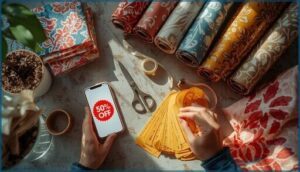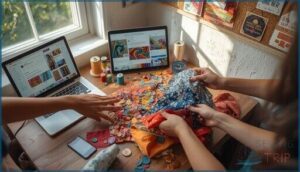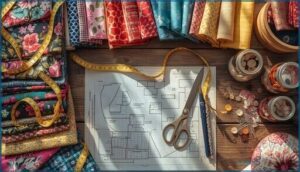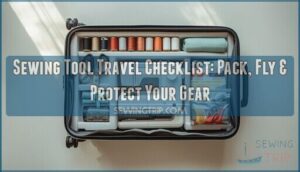This site is supported by our readers. We may earn a commission, at no cost to you, if you purchase through links.
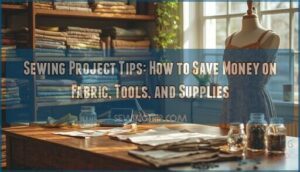
The difference between spending more and actually saving comes down to strategy. When you know where to find affordable materials, how to stretch every yard of fabric, and which projects deliver real value, sewing transforms from an expensive hobby into a genuine money-saver.
Smart choices at every stage—from sourcing supplies to planning your next project—can cut your costs in half while keeping quality high.
Table Of Contents
Key Takeaways
- Sewing saves money only when you use smart strategies like sourcing fabric from thrift stores, remnant bins, and clearance sales where you can cut costs by 50-80% compared to retail pricing.
- Zero-waste cutting techniques, scrap optimization, and upcycling old clothing transform waste into usable materials while keeping your budget lean and sustainable.
- Tracking your fabric inventory prevents duplicate purchases and helps you compare DIY material costs against retail prices to identify projects that actually deliver 30-50% savings.
- Planning your wardrobe strategically and prioritizing quality over quantity means you’ll spend less long-term by creating durable garments you’ll actually wear instead of churning out cheap projects that fall apart.
Is Sewing Expensive? Key Cost Factors
Wondering if sewing is actually a money-saver or just another expensive hobby? The real answer depends on a handful of things that can surprise beginners and seasoned sewists alike.
Let’s take a quick look at what shapes the cost before you thread that needle.
Fabric Vs. Ready-Made Clothing Costs
Here’s the reality: fabric costs can surprise you. Cotton fabric runs $7 to $15 per yard, while specialty materials like silk hit $40 to $150. Compare that to ready-made clothing—a basic shirt costs $126 to $207 retail, but production only runs $42 to $69. The difference? Mass production beats DIY pricing.
Fabric costs often exceed ready-made clothing prices because mass production beats DIY economics
Consider these cost comparison factors:
- Fabric scraps and upcycling turn remnants into textile savings
- Sustainable sewing practices reduce garment budgeting waste
- Sewing on a budget means tracking fabric pricing carefully
Understanding the fabric cost factors is essential for making informed decisions. Sewing economics aren’t always straightforward, but understanding these numbers helps you make smarter choices.
Quilting and Apparel Sewing Expenses
Quilting and apparel sewing each bring their own price tags, and knowing where your money goes makes all the difference. Quilting expenses stack up fast—batting, backing fabric, and thread add to fabric budgeting challenges. Apparel pricing varies widely based on pattern complexity and fabric choice.
Smart sewing cost-saving strategies include using fabric scraps for quilts and upcycling old garments into new apparel. Sustainable sewing practices help you stay sewing on a budget while reducing waste.
Calculating Savings on DIY Projects
Cost analysis transforms sewing from a hobby into a budget-friendly strategy. Compare your material costs and labor time against retail pricing to see real savings. Track DIY pricing using a simple spreadsheet—list fabric, notions, and hours spent.
Many sewists find material savings of 30-50% on basic garments when using affordable fabric and efficient techniques. Budget tracking reveals where you’re actually saving money while sewing, helping you make smarter choices about which projects deliver the best value.
By applying techniques for sewing money savings, sewists can refine their hobby for better financial returns.
Sourcing Affordable Fabric and Supplies
Finding affordable fabric doesn’t mean sacrificing quality or style. You just need to know where to look and how to make smart choices.
Here are four proven ways to stretch your sewing budget without cutting corners.
Thrift Stores, Remnants, and Bulk Buys
You’ve heard thrift stores are goldmines for sewers—and the numbers back it up. Secondhand shopping slashes fabric costs by 50-75% compared to retail. Hunt thrift stores for dress shirts, curtains, and table linens you can refashion into new projects. Here’s where to score the best deals:
- Thrift store finds: Check for vintage notions, bundled buttons, and zippers at 60-80% off retail prices.
- Remnant bins: Grab fabric remnants in bulk at resale outlets for 70% less per yard.
- Upcycled bed sheets: One thrifted sheet yields over 6 yards of usable fabric at a fraction of new costs.
- Bulk buying bundled lots: Score yarn bundles for $2 instead of $8-20 retail.
- Clearance fabric: Shop manufacturer surplus at specialized outlets for 60-75% below retail value.
Sustainable sourcing isn’t just eco-friendly—it’s wallet-friendly too.
Shopping Sales, Clearance, and Using Coupons
Timing your fabric purchases around sales and stacking coupons can cut your sewing budget in half without sacrificing quality. Hit discount stores during end-of-season clearance—you’ll find premium fabrics marked down 60-80%.
Online retailers often offer coupon codes that stack with existing sales. Sign up for email lists at your favorite fabric shops to catch flash sales early.
Cashback apps add another layer of savings on top of your coupons. This smart approach to budget sewing means more projects without the guilt.
Connecting With Sewing Communities for Deals
Sewing Community Support unlocks surprising savings. Join a Facebook group or local guild—members get discounts of up to 25% through partnerships. Bulk Orders with fellow sewists drop costs by 30-40%.
Fabric Swaps trade unused materials for free, saving $50-$300 yearly. Online forums share flash sale alerts.
Pinterest board communities post Group Buys for wholesale rates.
Using Cashback Apps for Extra Savings
Every time you click “buy,” a cashback app quietly stacks pennies back into your pocket—and those pennies add up fast when you’re restocking thread, zippers, and yards of fabric. Apps like Rakuten and Ibotta offer cashback rewards of 2-10% on online coupons at major craft retailers.
Download three apps, stack app discounts with store sales, and watch digital savings pile up. These rebate programs turn budget-friendly sewing strategies into frugal sewing wins—your sewing cost saving just got easier.
Smart Sewing Techniques to Reduce Waste
Every cut you make is a chance to stretch your fabric further and keep more scraps in play. The techniques below turn careful planning into real savings while keeping waste out of the trash.
Here’s how to make every inch count.
Zero-Waste Cutting and Scrap Optimization
Think of fabric scraps like puzzle pieces—once you learn to see the potential in every little bit, nothing ends up in the trash. Start with zero-waste cutting techniques that arrange pattern pieces strategically to minimize leftover fabric.
Save small scraps for patchwork, appliqué, or stuffing projects. Implement scrap management bins sorted by size and color. Even tiny pieces work for weaving bookmarks or sustainable sewing crafts.
This approach maximizes fabric efficiency while reducing waste markedly.
Refashioning and Upcycling Old Clothing
Your closet holds goldmine potential—old jeans, worn shirts, and thrift store finds can become sustainable fashion treasures through refashioning. Upcycling old clothing slashes costs while keeping textiles out of landfills (85% of U.S. textiles end up there otherwise).
Five easy upcycled textiles projects:
- Transform oversized shirts into fitted tops or eco-friendly tote bags
- Patch worn jeans with creative recycling techniques for trendy deconstructed denim
- Convert dresses into skirts or refashioned clothing pieces
- Repurpose old clothing into quilted pillows or home décor
- Redesign thrift store blazers with updated embroidery or dyeing
This creative approach keeps repurposing old clothing accessible to everyone.
Using Free and Draft-Your-Own Patterns
Pattern costs vanish when you discover thousands of free designs online or learn to draft patterns from clothes you already own. Free pattern sites like Mood Sewciety offer beginner-friendly options, while pattern drafting lets you achieve a custom fit without software.
Start with drafting basics—trace favorite garments onto paper, then try pattern hacking to modify designs. These sewing tips and tricks turn finding free sewing patterns into creative freedom.
Prioritizing Quality Over Quantity
Instead of churning out ten mediocre projects, build one garment you’ll wear for years—you’ll spend less in the long run and actually use what you make. Quality tools and fabric selection drive cost efficiency by eliminating do-overs.
- Choose durable fabrics that withstand repeated washing
- Master time management by perfecting techniques before scaling up
- Apply quality control at every seam to prevent costly mistakes
- Practice sustainable sewing through frugal sewing strategies that last
Budget-friendly sewing strategies and sewing cost analysis prove sewing efficiency strategies beat fast fashion economics.
Organizing and Maintaining Sewing Tools
Your tools will last longer and your budget will thank you when you keep things organized. A simple tracking system stops you from buying thread you already own or searching for scissors buried under fabric scraps.
Let’s look at three practical ways to manage your sewing gear without losing your mind.
Inventory Tracking to Avoid Duplicate Purchases
You don’t need five bottles of the same thread color hiding in three different drawers—and a simple inventory system will stop that from happening. Track your fabric stash and notions with a quick spreadsheet or even a notebook. Update it after each project to keep your sewing budgeting on point and prevent wasteful duplicate purchases.
| Item Type | Color/Details | Quantity |
|---|---|---|
| Thread | Navy Blue #310 | 2 spools |
| Elastic | 1″ Black | 3 yards |
| Zippers | 12″ Metal Silver | 4 units |
| Fabric Scraps | Cotton Floral | 1.5 yards |
| Buttons | White 15mm | 18 pieces |
This stockroom optimization approach transforms sewing organization from chaos into budget-friendly sewing strategies that actually work.
Regular Cleaning and Maintenance Routines
Keeping your sewing machine lint-free and your scissors sharp isn’t just good practice—it’s how you avoid throwing money at replacements and repairs. Oil your sewing machine every few months and brush out lint after big projects. Sharpen your sewing tools yearly or when they start tugging fabric.
Clean your sewing kit regularly to extend equipment life and prevent costly breakdowns that drain your budget.
Storing Supplies for Longevity and Easy Access
Once your tools are clean and sharp, proper storage is what keeps them that way—and stops you from buying duplicates of things you already own. Use clear storage bins with label organization so you can see your notions at a glance.
Keep fabric storage neat with supply shelving or stacked tool boxes.
A simple inventory system for your sewing supplies prevents waste and saves money.
Planning Projects for Maximum Savings
The smartest way to save money on sewing isn’t just about finding cheap supplies. It’s about planning ahead so you’re not buying more than you need or wasting what you already have.
Here’s how to think through your projects before you start cutting.
Wardrobe Planning and Pattern Selection
Planning your wardrobe silhouette before you hit “buy” on that pattern will save you from stacking up designs that never quite fit your style—or your budget. Think about your wardrobe planning like building a capsule: choose a fabric palette and stick to it, then prioritize pattern selection around pieces you’ll actually wear.
Pattern mixing becomes easier when you forecast your style needs, making fabric sourcing and sewing efficiency work together seamlessly.
Efficient Use of Fabric in Projects
Every inch of fabric matters when you’re watching your budget, so learning to squeeze the most from your yardage turns good projects into great deals. Start with zero waste cutting techniques—lay your pattern pieces like a puzzle to eliminate gaps.
Measure twice and cut once to avoid costly mistakes, and use muslin underlays when you’re nervous about efficient cutting on expensive textiles.
Save fabric scraps in labeled bins by size and color for later patchwork or trim.
Making Handmade Gifts to Offset Costs
Handmade gifts turn your sewing skills into currency—you save cash while giving something store-bought price tags can’t touch. Think of it as offsetting your hobby costs through gift-giving while spreading unique joy.
Try these DIY gifts on a budget:
- Quilted potholders from fabric scraps—practical and charming for housewarming presents
- Tote bags with fun prints—everyone needs another reusable bag, and they cost pennies to make
- Baby blankets or bibs—new parents treasure handmade items that show you care
Some sewists even launch a small crafting business, turning sewing for others into actual profit.
Frequently Asked Questions (FAQs)
How can I save money on sewing projects?
You know that moment when you’re standing in a fabric store, excited about a project, then the checkout total makes your eyes water?
Smart sewing on a budget starts with fabric budgeting, thrift shopping, and supply optimization to keep costs down without sacrificing creativity.
How do I save money on sewing tools and notions?
You don’t need to buy every gadget. Start with basics like sharp scissors and quality thread, then hunt tool discounts during supply sales.
Budget sewing means maintaining what you own and swapping notions with friends for frugal crafting success.
How can I make the most of my sewing budget?
Your fabric stash becomes your best asset when you prioritize DIY savings through smart budget planning.
Use sewing hacks like zero-waste cutting, shop sales strategically, and track inventory to master budget-friendly sewing strategies that turn frugal sewing into efficient creativity.
How can a sewist save money?
You’ll discover that thrift shopping and fabric budgeting transform sewing on a budget into reality.
Apply cost tracking, supply swapping, and sewing hacks to master frugal sewing with budget-friendly sewing strategies.
Can you sew on a budget?
Yes, sewing on a budget is totally doable. Budget-friendly sewing strategies like fabric recycling, thrift store finds, and DIY sewing hacks make cost-effective sewing realistic.
Frugal sewing means smart choices—not skimping on creativity.
How can I make sewing more sustainable?
Like planting a seed that grows into something beautiful, sustainable sewing transforms scraps into treasures. Use eco-friendly fabrics, repurposed materials, and zero-waste cutting techniques.
Upcycling old clothes promotes circular design and frugal living while reducing fashion waste beautifully.
How do beginners choose the right sewing machine?
Start by checking machine types that match your sewing needs and budget options. Compare brands through user reviews in the sewing community. Basic models with essential sewing tools work great for beginners following budget-friendly sewing tips.
What are essential tools for starting sewing projects?
Think of your toolkit as a foundation—without the right base, everything wobbles. You’ll need a reliable sewing machine, sharp fabric cutters, accurate measuring tools, quality thread types, and basic sewing notions like pins and needles to get started confidently.
How can sewers earn money from their hobby?
You can turn your skills into income through selling handmade gifts, offering sewing lessons, or affiliate marketing.
Try pattern design, sewing blogging, or connecting with the sewing community.
DIY sewing projects from thrift stores add value while making money.
What fabrics work best for budget-friendly projects?
Cotton blends and budget knits offer softness without the price tag. Clearance fabric and fabric remnants from sales bins stretch your dollar further. Repurposed textiles from thrift stores give eco-friendly, affordable sewing techniques a sustainable edge.
Conclusion
That $80 dress taught me something most sewists learn the hard way: good intentions don’t equal savings. But once you master the sewing project tips saving money strategies—from hunting remnants to squeezing every scrap from your fabric—you’ll watch those costs plummet.
The real victory isn’t just what you save today. It’s building a system that keeps paying off with every stitch, turning what used to drain your wallet into a skill that actually fills it back up.


